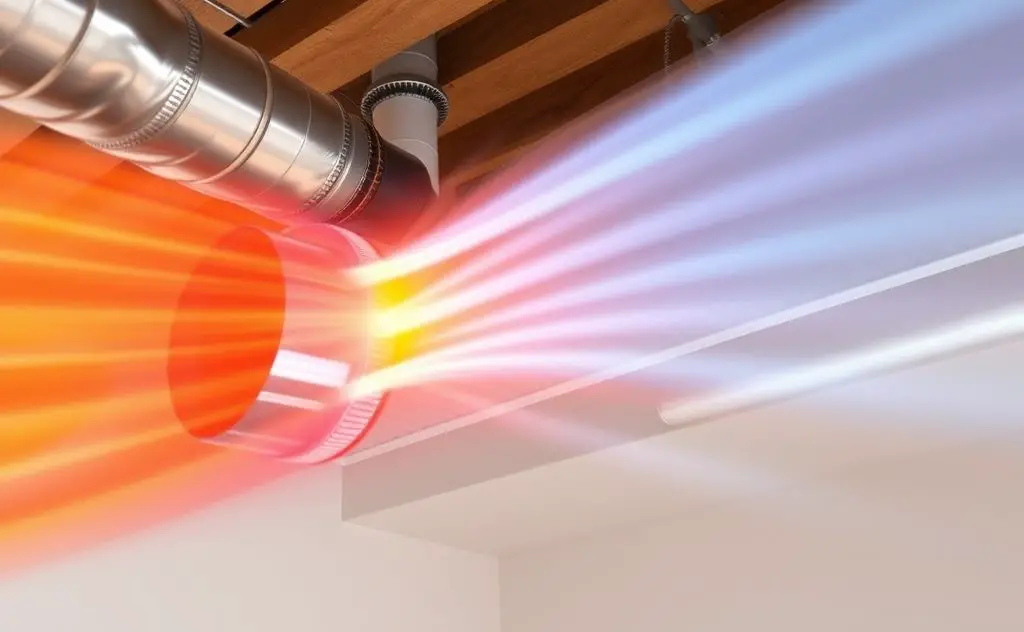A ducted central heater works by heating air in a furnace, which is then distributed through ducts to various rooms, ensuring even warmth throughout the space.
Ducted central heaters provide whole-home warmth by distributing heated air through a network of ducts. These systems offer efficient, even heating for any size home. Understanding how they operate helps homeowners make informed decisions about installation and maintenance.

Core Components of a Ducted Heating System
Every ducted central heater consists of several key components working together:
Heat Source
The furnace serves as the heart of the system. Modern options include:
- Gas furnaces (natural gas or propane)
- Electric resistance heaters
- Heat pumps (which can also cool)
Air Distribution System
Ductwork carries warm air throughout the home. Properly sized and sealed ducts ensure efficient operation. For those considering alternative heating options, built-in gas heaters offer a ductless solution for specific rooms.
Control System
A thermostat regulates temperature by signaling when to activate the heating cycle. Modern smart thermostats provide precise control and energy savings.

The Heating Process Step-by-Step
1. Thermostat Activation
When room temperature drops below the set point, the thermostat signals the furnace to begin heating.
2. Heat Generation
In gas systems, burners ignite to heat the heat exchanger. Electric systems use resistance coils. Heat pumps extract warmth from outdoor air even in cold temperatures.
3. Air Circulation
A blower fan pushes air across the heated surfaces and into the ductwork. According to U.S. Department of Energy, proper fan operation is crucial for efficiency.
4. Air Distribution
Heated air travels through ducts to vents in each room. The system maintains pressure balance by drawing cooler air back through return ducts.
5. Temperature Maintenance
The cycle continues until the thermostat senses the desired temperature has been reached.
Types of Ducted Central Heaters
Gas Furnaces
Most common in colder climates, gas furnaces offer quick, powerful heating. They require proper venting for combustion gases.
Electric Furnaces
These use heating elements similar to electric heaters that resemble wood stoves, but on a larger scale. While cleaner, they typically have higher operating costs.
Heat Pumps
These versatile systems provide both heating and cooling by reversing refrigerant flow. The Air-Conditioning, Heating, and Refrigeration Institute notes modern models work efficiently even in cold climates.
Energy Efficiency Considerations
Key factors affecting efficiency include:
| Component | Efficiency Impact |
|---|---|
| AFUE Rating | Measures fuel conversion efficiency (higher is better) |
| Duct Insulation | Reduces heat loss in unconditioned spaces |
| Variable Speed Blowers | Adjust airflow for optimal performance |
Maintenance Requirements
Regular maintenance ensures peak performance:
- Monthly filter changes during heating season
- Annual professional inspection
- Duct cleaning every 3-5 years
- Burner cleaning for gas systems
Advantages of Ducted Systems
- Whole-home comfort from single system
- Can integrate with central air conditioning
- Generally lower operating costs than multiple space heaters
- Improved air quality with proper filtration
Installation Considerations
Proper installation affects performance and longevity:
- Correct sizing based on Manual J load calculation
- Duct design minimizing bends and restrictions
- Appropriate venting for combustion systems
- Zoning options for larger homes

